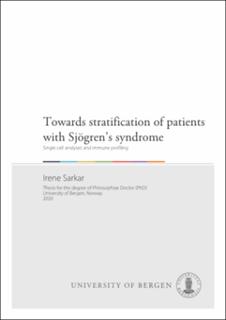| dc.contributor.author | Sarkar, Irene | |
| dc.date.accessioned | 2020-10-30T14:49:09Z | |
| dc.date.available | 2020-10-30T14:49:09Z | |
| dc.date.issued | 2020-11-06 | |
| dc.date.submitted | 2020-10-14T15:21:51.572Z | |
| dc.identifier | container/d5/20/54/81/d5205481-f16c-4e0b-a534-1a713fbd3d0d | |
| dc.identifier.isbn | 9788230857915 | |
| dc.identifier.isbn | 9788230863282 | |
| dc.identifier.uri | https://hdl.handle.net/1956/24446 | |
| dc.description.abstract | Primary Sjögren’s syndrome (pSS) is a systemic, chronic autoimmune disorder that is characterized by progressive lymphocytic infiltration in the exocrine glands i.e., the salivary and lacrimal glands, leading to immune-mediated glandular destruction. It mostly affects middle-aged women, making diagnosis of the disease challenging, as the symptoms (primarily dryness of the mouth and eyes and fatigue) are often confused with the side effects of drugs, other comorbidities or aging. Currently there is no cure, as the exact mechanism of the disease pathogenesis is not known, and treatment strategies mainly aim at alleviating the symptoms. Like most autoimmune diseases, pSS progression and phenotype are complex and multi-faceted, with a wide spectrum of clinical manifestations, ranging from local to systemic, including fatal conditions like B cell lymphoma. Patient heterogeneity is a major obstacle to disease management. Therefore, it is imperative to identify potential disease markers that may help in diagnosis, prediction, stratification of the patients and/or identification of new therapeutic targets.
The overall aim of this thesis was to study the peripheral blood immune system in pSS, to identify disease-specific immune profiles and potential biomarkers that may help in patient stratification. In paper I, phosphoflow cytometry was used to compare basal and TLR7 and -9 stimulated phosphorylation states in immune cells of pSS patients and healthy donors. Both basal and stimulation-induced phosphorylation differed significantly between pSS patients and healthy individuals, and between patient subgroups. Plasma cytokine levels, measured by Luminex assay, also differed significantly between the patients and controls as well as between patient subgroups, and correlated with autoantibody status and other clinical parameters.
In paper II, single cell analysis of peripheral blood immune cells, with special emphasis on intracellular signaling, was done using mass cytometry. We compared the frequencies of different immune cell subsets among the patient subgroups and healthy individuals and analyzed their signaling profiles, upon stimulation with IFNα2b and IFNγ separately. Significant differences in cell frequencies were observed among the SSA- and SSA+ pSS patients and controls, along with increased activation status in many cell types, particularly in the SSA+ subgroup. Upon IFNα2b and IFNγ stimulation, aberrations in phospho-signaling were detected in the various immune cell subsets of the patient subgroups, which were most prominent in the SSA+ pSS patients.
In paper III, we used flow cytometry and qPCR to analyze the expression of TAM receptors in various immune cells of pSS patients and healthy controls. Significant differences in the mRNA levels of some of the TAM receptors as well as in cell frequencies were observed between the patients and healthy donors. Differential TAM receptor expressions in the immune cells were detected between the pSS patients and healthy controls, with most of them being expressed at slightly lower levels in the patients.
In conclusion, aberrations in cellular compositions, cytokine and TAM receptor levels as well as discrepancies in intracellular signaling pathways were detected in the pSS patients and their subgroups compared to healthy individuals. Further research can shed light on new biomarkers for stratification of patients for personalized treatment. Optimized therapeutic strategies can greatly alter the disease outcome and quality of life. | eng |
| dc.language.iso | eng | eng |
| dc.publisher | The University of Bergen | eng |
| dc.relation.haspart | Paper I: Single cell based phosphorylation profiling identifies alterations in Toll-like
receptor 7 and -9 signaling in patients with primary Sjögren’s syndrome
Richard Davies, Irene Sarkar, Daniel Hammenfors, Brith Bergum, Petra Vogelsang,
Silje M. Solberg, Sonia Gavasso, Johan G. Brun, Roland Jonsson, Silke Appel. Front
Immunol (2019) 10:281. The article is available at: <a href="http://hdl.handle.net/1956/22634" target="blank">http://hdl.handle.net/1956/22634</a> | eng |
| dc.relation.haspart | Paper II: Aberrant signaling of immune cells in Sjögren’s syndrome patient subgroups
upon interferon stimulation
Irene Sarkar, Anders K. Aarebrot, Silje M. Solberg, Aleksandra Petrovic, Richard
Davies, Anagha M. Joshi, Brith Bergum, Johan G. Brun, Daniel Hammenfors, Roland
Jonsson, Silke Appel. The article is not available in BORA. | eng |
| dc.relation.haspart | Paper III: Analysis of TAM receptor expression in patients with primary Sjögren’s
syndrome
Irene Sarkar, Kirsten Lassing, Aleksandra Petrovic, Richard Davies, Magdalena
Keindl, Johan G. Brun, Roland Jonsson, Silke Appel. The article is not available in BORA. | eng |
| dc.rights | In copyright | eng |
| dc.rights.uri | http://rightsstatements.org/page/InC/1.0/ | eng |
| dc.title | Towards stratification of patients with Sjögren’s syndrome : Single cell analyses and immune profiling | eng |
| dc.type | Doctoral thesis | eng |
| dc.date.updated | 2020-10-14T15:21:51.572Z | |
| dc.rights.holder | Copyright the Author. All rights reserved | eng |
| dc.description.degree | Doktorgradsavhandling | |
| fs.unitcode | 13-25-0 | |
